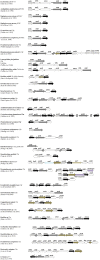Distribution of Arsenic Resistance Genes in Prokaryotes
- PMID: 30405552
- PMCID: PMC6205960
- DOI: 10.3389/fmicb.2018.02473
Distribution of Arsenic Resistance Genes in Prokaryotes
Abstract
Arsenic is a metalloid that occurs naturally in aquatic and terrestrial environments. The high toxicity of arsenic derivatives converts this element in a serious problem of public health worldwide. There is a global arsenic geocycle in which microbes play a relevant role. Ancient exposure to arsenic derivatives, both inorganic and organic, has represented a selective pressure for microbes to evolve or acquire diverse arsenic resistance genetic systems. In addition, arsenic compounds appear to have been used as a toxin in chemical warfare for a long time selecting for an extended range of arsenic resistance determinants. Arsenic resistance strategies rely mainly on membrane transport pathways that extrude the toxic compounds from the cell cytoplasm. The ars operons, first discovered in bacterial R-factors almost 50 years ago, are the most common microbial arsenic resistance systems. Numerous ars operons, with a variety of genes and different combinations of them, populate the prokaryotic genomes, including their accessory plasmids, transposons, and genomic islands. Besides these canonical, widespread ars gene clusters, which confer resistance to the inorganic forms of arsenic, additional genes have been discovered recently, which broadens the spectrum of arsenic tolerance by detoxifying organic arsenic derivatives often used as toxins. This review summarizes the presence, distribution, organization, and redundance of arsenic resistance genes in prokaryotes.
Keywords: ars operon; arsenic; efflux; mine railings; remediation; resistance.
Figures



Similar articles
-
Microbial interactions in the arsenic cycle: adoptive strategies and applications in environmental management.Rev Environ Contam Toxicol. 2013;224:1-38. doi: 10.1007/978-1-4614-5882-1_1. Rev Environ Contam Toxicol. 2013. PMID: 23232917 Review.
-
Role of arsenic and its resistance in nature.Can J Microbiol. 2011 Oct;57(10):769-74. doi: 10.1139/w11-062. Epub 2011 Sep 21. Can J Microbiol. 2011. PMID: 21936668 Review.
-
Metalloid resistance mechanisms in prokaryotes.J Biochem. 1998 Jan;123(1):16-23. doi: 10.1093/oxfordjournals.jbchem.a021904. J Biochem. 1998. PMID: 9504403 Review.
-
Genomic evidence reveals the extreme diversity and wide distribution of the arsenic-related genes in Burkholderiales.PLoS One. 2014 Mar 14;9(3):e92236. doi: 10.1371/journal.pone.0092236. eCollection 2014. PLoS One. 2014. PMID: 24632831 Free PMC article.
-
Corynebacterium glutamicum as a model bacterium for the bioremediation of arsenic.Int Microbiol. 2006 Sep;9(3):207-15. Int Microbiol. 2006. PMID: 17061211 Review.
Cited by
-
Genomic Variation and Arsenic Tolerance Emerged as Niche Specific Adaptations by Different Exiguobacterium Strains Isolated From the Extreme Salar de Huasco Environment in Chilean - Altiplano.Front Microbiol. 2020 Jul 15;11:1632. doi: 10.3389/fmicb.2020.01632. eCollection 2020. Front Microbiol. 2020. PMID: 32760381 Free PMC article.
-
Introducing the ArsR-Regulated Arsenic Stimulon.Front Microbiol. 2021 Mar 3;12:630562. doi: 10.3389/fmicb.2021.630562. eCollection 2021. Front Microbiol. 2021. PMID: 33746923 Free PMC article.
-
Pathways of arsenic uptake and efflux.Environ Int. 2019 May;126:585-597. doi: 10.1016/j.envint.2019.02.058. Epub 2019 Mar 8. Environ Int. 2019. PMID: 30852446 Free PMC article. Review.
-
The Human Gut Microbiome's Influence on Arsenic Toxicity.Curr Pharmacol Rep. 2019 Dec;5(6):491-504. doi: 10.1007/s40495-019-00206-4. Epub 2019 Nov 25. Curr Pharmacol Rep. 2019. PMID: 31929964 Free PMC article.
-
In-depth genome and pan-genome analysis of a metal-resistant bacterium Pseudomonas parafulva OS-1.Front Microbiol. 2023 Jun 20;14:1140249. doi: 10.3389/fmicb.2023.1140249. eCollection 2023. Front Microbiol. 2023. PMID: 37408640 Free PMC article.
References
Publication types
LinkOut - more resources
Full Text Sources
Molecular Biology Databases

